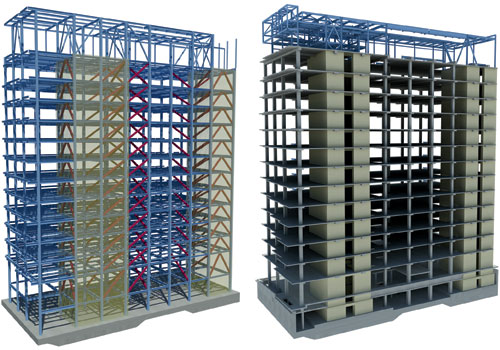Green at Its Core
 |
||
|
The LEED rating system contains no credits that pertain to seismic design. Nevertheless, the PUC team members regard the structural frame as one of the building's primary green attributes. They hope that this durability will earn the project points for innovation. "Resilience is one of the fundamental design goals," says David Mar, Tipping Mar principal. "It is deeply coupled with the client's notion of sustainability."
The structural system includes what is sometimes referred to as a "rocking mechanism" because its
elements are designed to return to their original position after an earthquake's shaking. It relies on post-tensioned concrete slabs and two vertically post-tensioned concrete cores. The tensioned tendons, housed unbonded inside ducts placed between the rebar, provide a restoring force, closing cracks that will develop in the concrete during a quake, explains Mar.
Initially, plans for the PUC building called for a steel structure - one with the same column grid and core locations - but with a special-moment frame that included viscous dampers. Like the post-tensioned concrete building under construction now, the steel version was designed to allow the agency's staff to maintain continuous operations after a DBE. But during a more extreme event, the concrete frame should perform better, especially in the area of internal acceleration, says Mar. For example, his team studied the ability of the two sytems to protect mechanical equipment secured with standard bracing. They found that the concrete scheme was able to withstand higher accelerations.
Â
 |
LEFT. Initially, the building had a steel special-moment-frame structure with viscous dampers (shown in red). RIGHT. As part of an aggressive cost-cutting process, engineers redesigned the structure in concrete, but retained the same column grid and core locations. By swapping the structural system and eliminating suspended ceilings, designers fit another office floor within the same zoning envelope. Images: courtesy Tipping Mar |
Â
An animation of the San Francisco Public Utilities Commission headquarters illustrates how the building will respond to a code-level earthquake. Displacement has been magnified 10 times from actual values. Video courtesy Tipping Mar |
|
| Â |
An animation of the construction sequence for the San Francisco Public Utilities Commission headquarters highlights the components of the building's post-tensioned concrete cores. Video courtesy Tipping Mar |
|
| Â |









